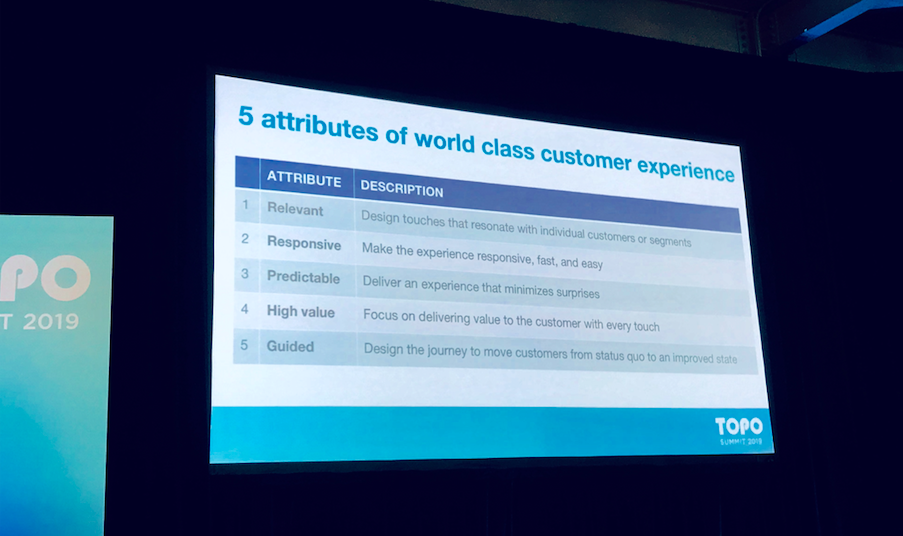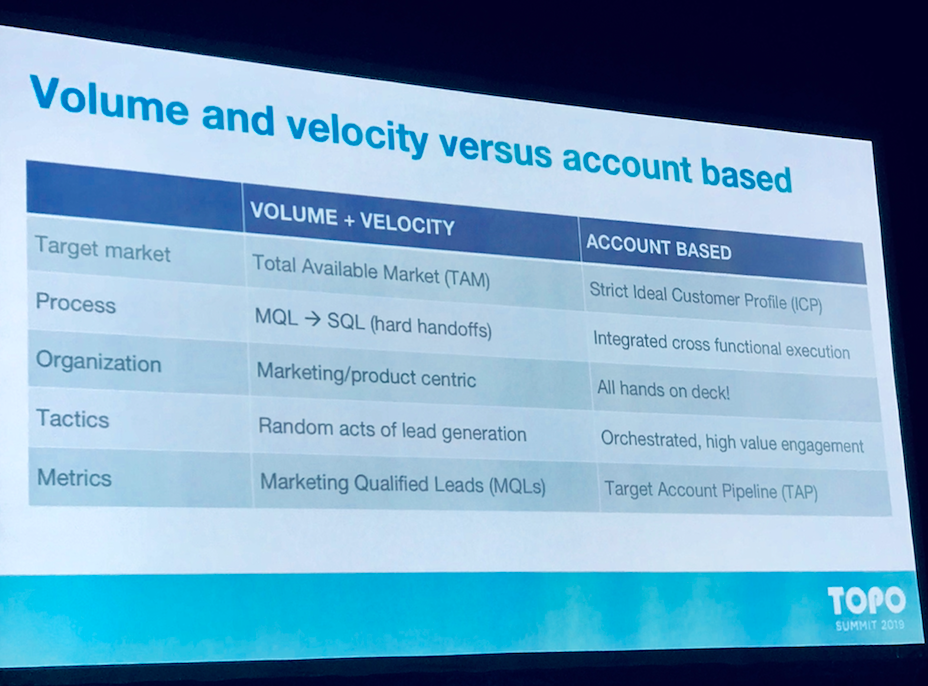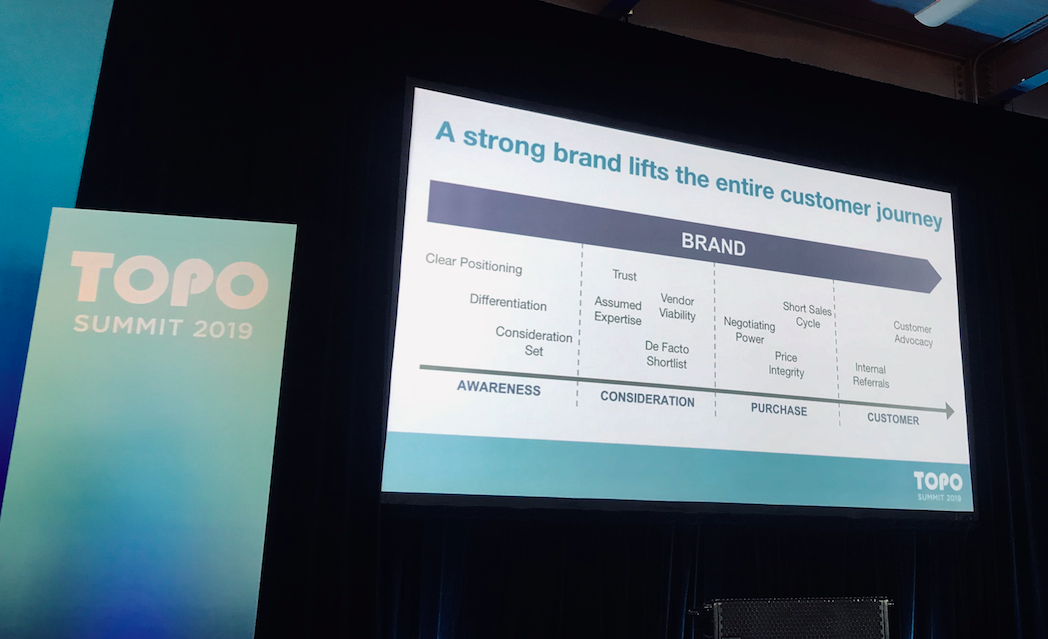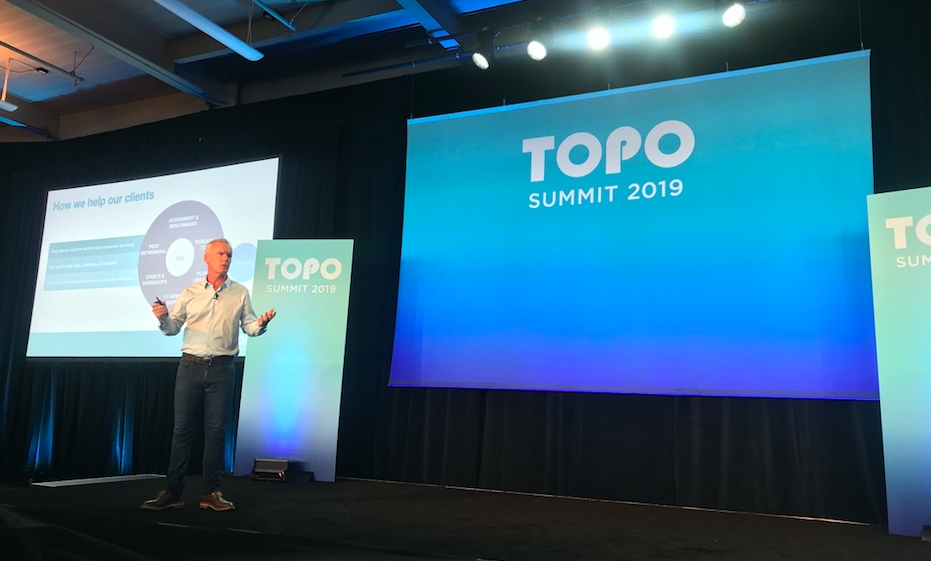TOPO’s annual Summit brought hundreds of sales and marketing professionals to San Francisco’s Pier 27 for two days of learning around topics such as marketing ops and tech, sales development and effectiveness, as well as account-based marketing and sales ops and tech. TOPO analysts and practitioners from companies such as Cloudera, ServiceNow, Zoom and more took the stage on April 17-18 to share their insights into the latest trends and best practices fueling modern B2B marketing and sales practices.
During his opening keynote, TOPO Founder and CEO Scott Albro put the spotlight on five big ideas his analyst and consulting team believe will make an impact on sales and marketing practices in 2019 and beyond. These themes really set the stage for the rest of the show:
- Customer experience;
- Go-to-market fit;
- B2B brand power;
- The data paradox; and
- People, ideas and technology.
CX Is The Key Differentiator In Today’s Economy

Customer experience is what sets companies apart in this day and age, Albro said. It is the key differentiator because commoditization has changed everything. The abundance of products and information at the hands of buyers is greater than ever before. With more than 7,000 martech vendors on Scott Brinker’s new “Supergraphic” and millions of results on Google when you search for “martech,” the abundance is undeniable.
“The reason this commoditizes a market is because the buyer thinks they have all these options and we’re starting to live in a world with commoditized products,” said Albro. “So, you have to focus on the customer experience — not just for customer support, but also for marketing, sales development, sales and marketing ops, etc.”
To deliver a world-class customer experience, Albro pointed to five key attributes to focus on:
- Relevant — “Design an experience that’s relevant to a specific customer or segment,” he said. “Experience is different from A accounts to C accounts.”
- Responsive — “Buyers think B2B vendors are way too slow because they’re thinking in a consumer mindset,” said Albro. “We need our CX to be responsive, fast, easy.”
- Predictable — “Buyers hate surprises in a B2B world. You want to deliver a CX that’s expected.”
- High value — “Focus on delivering value to customers in the sales cycle. They want a high-value experience… even from SDRs,” Albro continued.
- Guided — “How do we take our buyer or customer from status quo to some type of new state? And how do we do that in a way so that the buyer knows we’re proactively managing it?”
Finding Go-To-Market Fit Is The Foundation Of Revenue Growth

Most B2B marketing organizations have their tactics down; they’ve secured the right tech stack and made a lot of correct tactical decisions, according to Albro. But many still lack the right foundation or go-to-market strategy.
He said there are two ways to think about this:
- Focusing on being primarily “volume and velocity” focused similar to a traditional, inbound demand generation-type model; or
- Focusing on being account-based.
Albro said that in order to gauge which axis you fall under, you need to think about what your target market looks like. “One question you might ask is are there hundreds of thousands of customers in my market? Or are there hundreds of customers in our market?” he said. “We have clients that have both. RingCentral segmented their market, but they used to only care about the 30M businesses in North America. That was their target market. That’s a volume and velocity model.
“We also have a client and their target market was the eighth largest consumer package goods companies in the world. That’s it, eight companies. You can’t do volume and velocity there, [or else] you’ll wait a long time for a lead to come in there. So, they’re account-based.”
Albro also noted that if you’re selling to, say, 30 million businesses at $10 a month, it must be easy for them to buy and use — that’s volume and velocity. But if you’re selling a $20 million deal to one major company, that’s more complex because you will spend a lot of money and time marketing and selling that.
“There are big differences in these go-to-market models and it’s important to understand which one your dominant go-to-market strategy is,” said Albro. “You do need to identify your dominant go-to-market strategy, but you also need to make sure you’re willing to potentially borrow from the other strategy and create a hybrid model. You have to be aware of what we call the ‘either or’ trap.”
He pointed to two TOPO customers that have figured out how to grow along both of these axes:
The first was ServiceNow, a provider of digital workflows for enterprise. “They started in the enterprise and have been masters at driving really high lifetime value on a per account basis,” said Albro. “If you look at their brand and marketing, it is all about helping individual users. There’s a clear decision to move further along the ‘number of customers’ axis. They’re really focused on usability. So, they said they’ve done great in terms of maximizing CLV and we will continue to maximize that. But were really interested in acquiring more customers and more users.”
The second was Twilio, a cloud communications platform provider. “They signed up 1.6 million developers to use their platform,” Albro continued. “What they’re doing now is focusing on adding quota capacity — adding account executives/quota-carrying reps to go monetize the developer base. They’ve done a great job in terms of starting out with number of customers/users, and now they’re focused on moving that economic axis, [including] ACV and LTV.”
Your Brand Is More Important Than Ever

Maintaining a strong brand presence is critical in today’s saturated market, yet, according to Albro, many organizations under-appreciate the importance of brand. “There is a strong correlation between strong brands and stock market success,” he said. “Strong brands drive growth.”
A strong brand is not just important for the awareness stage of the customer journey. “Brand can help you in so many different ways,” said Albro. “Break down the siloed thinking and ask how else the brand can help in the customer journey.”
He continued to break down some key benefits of how brand can help organizations enhance every stage of the customer journey:
- Awareness — clear positioning, differentiation, consideration set;
- Consideration — trust, vendor viability, assumed expertise;
- Purchase — short sales cycle, negotiating power, price integrity; and
- Customer — internal referrals, customer advocacy.
Furthermore, Albro shared a quick framework for building up a B2B brand, which simply involves asking three questions:
- Confidence — Does the buyer believe what you say? Do you inspire confidence?
- Competence — Does the buyer believe you have the skills/expertise to do what you say?
- Commitment — Does the buyer believe you are acting on their behalf?
“If you can positively answer those three questions, in B2B, that’s a strong brand. That’s what buyers want,” said Albro.
Balancing The Abundance Of Data With Quality And Usefulness
Marketing and sales professionals these days have a lot of data at their disposal, which, according to Albro, can be a blessing and a curse.
“The more data we acquire, the less useful it is,” he said. “So, how do we balance an abundance of data with quality and usefulness? As we acquire more data, how do you make that data usable and actionable?”
“It’s really hard… We have more and more data available to us. First, we had internal data — that was manageable. Then we had external data, like intent data, which is really powerful if you know how to use it. Now, we have these new forms of data that are coming, like a lot of the stuff around analyzing what’s happening on sales calls is really exciting. Again, if you know how to use it. I think of this as the data paradox.”
Albro continued to share a TOPO framework that can help distinguish between leaders and laggards when it comes to data:
- Data — What data do you have access to?
- Insights — How do you get true customer insights? Do you know your customer?
- Activation — Most importantly, how do you activate the data?
“The problem we all have with data now is that we have it, we look at it, we think we get an insight and then we don’t do anything with it,” said Albro. “There are some cool things happening around data activation. Imagine a world where you get some intent data from a third-party website and engagement data from your own website. That creates a score — that score tells you to do certain things and you have systems and tech in place that do those things for you.”
People, Ideas And Technology — In That Order
Finally, the importance of people in sales and marketing has been underemphasized the last few years, according to Albro. He referenced a quote from Air Force Colonel John Boyd, who said “People, ideas and technology — in that order,” which he said is a powerful way of thinking about your sales and marketing organization.
“As we think about teams and culture in sales and marketing organizations, we think there’s a useful tool to help you think about designing your organization,” said Albro. “Start with leadership — all things on top are important strategic things like do we have a shared purpose? Do we have value? Do the sales and marketing professionals value open communication? Do we have goals that are measurable? How do I translate the goals into an organizational design that allows me to hit them?”
“Finally, we get to the employee lifecycle — how do I hire the right people, onboard and enable them and advance them so they become leaders?”







